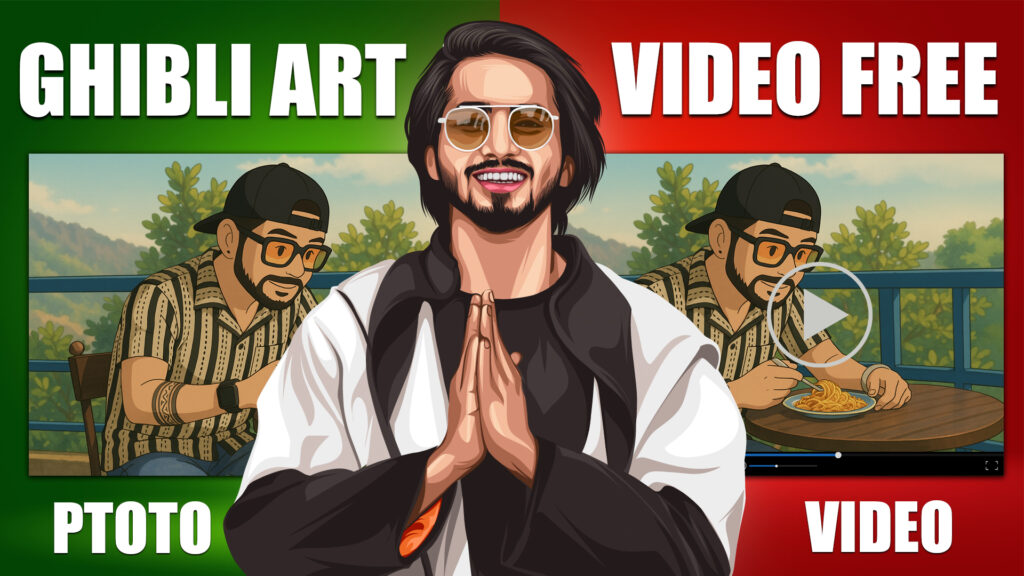Creating a Ghibli-Inspired Video from a Ghibli Image: A Step-by-Step Guide
Studio Ghibli is more than just an animation studio; it’s a creative force that has inspired generations of fans with its deeply emotive storytelling and beautifully crafted artwork. The unique art style of Ghibli is characterized by vibrant landscapes, magical characters, and intricate details that bring scenes to life in a way that feels both fantastical and deeply grounded in reality. In this post, we explore how to take a still image with Ghibli-inspired aesthetics and turn it into a captivating video. Whether you are an artist looking to breathe life into your artwork or an enthusiast wanting to bring the Ghibli magic into the digital realm, this guide will walk you through the process of creating a Ghibli-style video from a static image.
Copy This Prompt –
“Transform this image into a high-quality, ultra-realistic video.
Make the subject appear naturally animated with subtle facial expressions,
blinking, and slight head movements. Add realistic body motions such as gentle breathing and smooth hand gestures if applicable.
Ensure fluid motion with dynamic lighting and depth effects to enhance realism.
Maintain sharp details while creating a natural, cinematic feel.
Use 4K resolution with high frame rate for lifelike quality.”
Prompt Download
Understanding the Ghibli Art Style
Before delving into the technical aspects of turning a Ghibli-like image into a video, it’s important to understand what makes Ghibli’s art so enchanting. The studio is renowned for its stunning backgrounds, often featuring lush, vibrant landscapes, and fantastical elements. Whether it’s the deep forests from Princess Mononoke or the floating castles in Howl’s Moving Castle, Ghibli scenes evoke a sense of tranquility, wonder, and adventure.
Key characteristics of Ghibli’s artwork include:
- Rich, layered backgrounds: The environments in Ghibli films are meticulously designed, with layers of elements that create depth and dimension.
- Fluidity and subtle movement: Even in still images, Ghibli backgrounds often appear to breathe, as if the wind or the passage of time could make the scene come to life at any moment.
- A sense of magic: There is always an element of fantasy in Ghibli’s art. Whether it’s the glowing lights in Spirited Away or the floating dust in Kiki’s Delivery Service, magic is never far away.
The Process of Transforming a Ghibli Image into a Video
With these principles in mind, let’s dive into how you can take an image that encapsulates the Ghibli aesthetic and turn it into a dynamic video. The process can be broken down into several key stages: preparation, animation, sound design, and final editing.
1. Preparation: Choose Your Ghibli-Inspired Image
The first step is selecting the image you want to transform. This could be an original piece of art or an existing Ghibli scene that you want to animate. It’s important to choose an image that has a clear sense of depth and atmosphere. The best candidates will have multiple layers—such as foreground, middle ground, and background—allowing you to animate them separately for a more immersive experience.
For example, an image of a character standing in front of a lush forest would work well because you can animate the background (trees, clouds, sky) while keeping the character stationary. Look for elements within the image that can move or change to create a sense of life.
2. Breaking the Image into Layers
To bring the Ghibli scene to life, you need to separate different components of the image into individual layers. This can be done using image editing software such as Photoshop or GIMP.
For instance:
- Foreground: This might include the main characters, objects, or any elements that appear close to the viewer.
- Middle ground: Trees, small buildings, or pathways that lie between the viewer and the horizon.
- Background: The sky, distant mountains, or other elements far in the distance.
By isolating each element into separate layers, you can create the illusion of depth and movement, a technique known as parallax animation. This allows the viewer to feel like they are moving through the scene, even though it’s a static image.
3. Animating the Layers
Once your image is divided into layers, it’s time to animate. Animation software like Adobe After Effects or Blender can be used to add subtle movements to the scene. The goal here is to maintain the peaceful, slow-paced energy that is a hallmark of Ghibli’s animation style.
Subtle movements can include:
- Swaying trees: Use After Effects to gently animate the trees to create the illusion of wind blowing through the forest.
- Moving clouds: Have the clouds drift across the sky at a slow pace, mimicking the serene passage of time.
- Water ripples: If your scene includes water, you can animate the surface to ripple softly, making it feel alive.
To make the animation more natural, don’t overdo it. Ghibli’s animation is known for being subtle, so a few small details—like leaves rustling or light rays flickering through the trees—can have a big impact.
4. Adding a Camera Movement
Once the basic animations are in place, you can enhance the video by adding a camera movement. This could be a slow pan across the scene or a zoom-in to emphasize a certain detail. In Ghibli films, the camera often moves with a sense of calmness, allowing the viewer to absorb the environment without rushing.
You could, for example, create a gentle camera push towards a glowing object in the distance, giving the impression that the viewer is walking into the scene. If done thoughtfully, this adds a cinematic quality to your video.
5. Sound Design: Bringing the Scene to Life
The auditory experience is just as important as the visual in creating a Ghibli-inspired atmosphere. Sound design plays a huge role in Ghibli’s films, from the soft rustle of leaves to the distant sounds of nature.
Start by adding ambient sound effects, such as:
- Wind rustling through trees.
- Birdsong or distant animal sounds.
- Water flowing if there’s a stream or river in the scene.
Music is also an essential part of capturing the Ghibli spirit. Studio Ghibli films often feature orchestral soundtracks that evoke a sense of nostalgia, mystery, or wonder. Use a soft, atmospheric piece of music that complements the mood of your scene. It should enhance the visual without overwhelming it.
6. Final Editing and Polishing
Once the animation and sound are complete, it’s time to put everything together. Video editing software like Adobe Premiere Pro or Final Cut Pro allows you to combine your animated elements, sound effects, and music into a cohesive video.
- Pacing is key: Ghibli’s films often have slow, deliberate pacing, allowing each frame to breathe and the story to unfold naturally. Make sure your video follows this pacing, avoiding quick cuts or overly energetic scenes.
- Transitions: Use smooth fades or dissolves to transition between different parts of the scene. This can create a seamless flow, much like the transitions seen in Ghibli films.
- Color correction: Adjust the colors to give the video the warm, nostalgic feel typical of Ghibli films. Soft, earthy tones work best, and slight adjustments to contrast can help bring out the magical atmosphere.
7. Sharing Your Ghibli-Inspired Video
Once your video is complete, it’s time to share it with the world. Whether you choose to upload it to YouTube, Vimeo, or social media platforms like Instagram or TikTok, make sure to highlight the Ghibli inspiration behind your work. People are drawn to the whimsical, nostalgic qualities of Ghibli films, so sharing your creative process or the inspiration behind your video can help build a connection with viewers.
Conclusion
Turning a Ghibli-inspired image into a video is a wonderful way to honor the studio’s art style while exploring your own creativity. By carefully considering the key elements of Ghibli’s visuals—such as depth, fluidity, and a sense of magic—you can create a video that evokes the same emotions and awe that Ghibli’s animated films do. From breaking the image into layers to animating subtle movements, adding sound design, and final editing, each step is an opportunity to bring a piece of Ghibli’s enchanted world into motion.
So, whether you’re an aspiring animator, an artist, or a Ghibli fan, this process allows you to transform a single, static image into an immersive, magical experience that captures the essence of Ghibli’s timeless art and storytelling.


